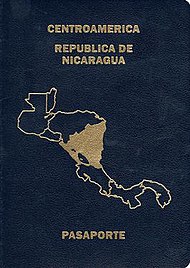Nicaraguan passport
| |
|---|---|
 The front cover of a contemporary Nicaraguan passport. | |
| Type | Passport |
| Issued by | |
| Purpose | Identification |
| Eligibility | Nicaraguan citizenship |
The Nicaraguan passport (Spanish: Pasaporte nicaragüense) is issued to citizens of Nicaragua for international travel. As of 1 January 2017, Nicaraguan citizens had visa-free or visa on arrival access to 112 countries and territories, ranking the Nicaraguan passport 46th in terms of travel freedom (tied with Marshallese passport) according to the Henley visa restrictions index.[1]
The current Nicaraguan passport has 89 security features, including bidimensional barcodes, holograms, and watermarks, and is reportedly one of the least forgeable documents in the world.[2]
Appearance
[edit]Like all Central American passports, the cover is navy blue with gold letters indicating the official name of the country in Spanish; at the top it has the words Centroamérica and in the middle a map of Central America showing the territory of Nicaragua shaded. At the bottom it has a text indicating the type of passport.
The passport consists of 48 pages. It is 124 mm in width and 86 mm in height.[3]
Identification page
[edit]- Photo of the passport holder
- Type ("P" for passport)
- Code of the country
- Passport serial number
- Surname and first name of the passport holder
- Citizenship
- Date of birth (DD. MM. YYYY)
- Gender (M for men or F for women )
- Place of birth
- Date of issue (DD. MM. YYYY)
- Passport holder's signature
- Expiry date (DD. MM. YYYY)
- Issuing authority
Validity
[edit]Passports for people over 16 years of age are valid for ten years and for people under 16 years of age for five years.
See also
[edit]References
[edit]- ^ "Global Ranking - Visa Restriction Index 2017" (PDF). Henley & Partners. Retrieved 14 March 2017.
- ^ "A brief history of the passport". The Guardian. 2006-11-17. Archived from the original on 2023-06-14.
- ^ "Document: NIC-AO-03001". European Council. Retrieved 2022-12-15.
- Council regulation 539/2001 [1]
- Council regulation 1932/2006 [2]
- Council regulation 539/2001 consolidated version, 19.1.2007 [3]
- List of nationals who do need a visa to visit the UK [4].
- List of countries whose passport holders do not require visas to enter Ireland [5].
